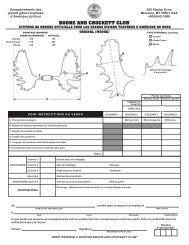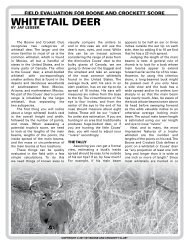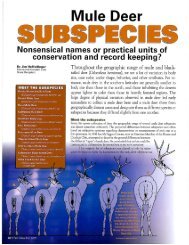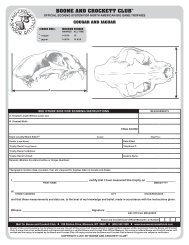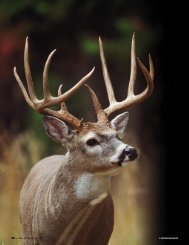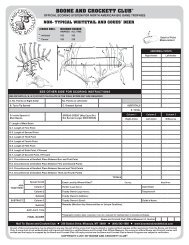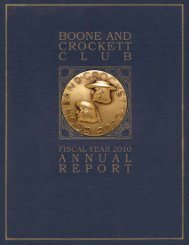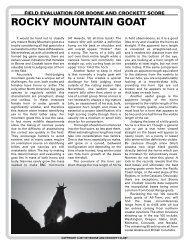WOLF ESSAY - Boone and Crockett Club
WOLF ESSAY - Boone and Crockett Club
WOLF ESSAY - Boone and Crockett Club
- No tags were found...
Create successful ePaper yourself
Turn your PDF publications into a flip-book with our unique Google optimized e-Paper software.
GEIST<strong>WOLF</strong> <strong>ESSAY</strong>Part 3 of 3©MICHAEL FRANCIS26 n Fair Chase Summer 2009
REAL:BEYOND <strong>WOLF</strong> ADVOCACY,TOWARD REALISTIC POLICIESFOR CARNIVORE CONSERVATIONLET’S GETInvestigations into the death of Kenton Carnegieunearthed matters that are deeply troubling (see “Death byWolves” in the Winter 2008 issue of Fair Chase). Under theguise of scientific authority, political advocates declaredthat black bears, notwolves, had killedKenton Carnegie. Byreporting these claimsBy Valerius Geist, Ph.D.B&C Professional MemberProfessor Emeritus, University of Calgaryin prestigious publications such as National Geographic <strong>and</strong>National Wildlife, they mislead the public into believingtheir version of the story. Never mind that the facts clearlyshowed otherwise, <strong>and</strong> that the official inquiry declaredwolves to be the cause of Kenton Carnegie’s death. Advocacywon the day, resulting in widespread belief that bears killedKenton Carnegie <strong>and</strong> that wolves are harmless.The North American myth of harmless wolves is deadly! This belief has killed atleast three persons in North America alone in the last decade including two bright, welleducatedyoung people. Witness the instances of children under parental care stickingfingers towards captive wolves in the innocent belief that wolves pose no threat. Imust confess that I, too, embraced the myth throughout my academic career <strong>and</strong>four years into retirement—based on years of experience with painfully shy Canadianwilderness wolves. It took a misbehaving pack on Vancouver Isl<strong>and</strong>, 1 <strong>and</strong> areview of historical matters, to teach me differently. 2Fair Chase Summer 2009 n 27
GEIST<strong>WOLF</strong> <strong>ESSAY</strong>Part 3 of 3Myth of the Benign WolfAdvocacy behind the “benign wolf” mythis extremely powerful. It almost seems thatthe better educated people are, the morelikely they are to believe <strong>and</strong> fall victim tothis myth. Such was the case with KentonCarnegie, <strong>and</strong> also 24-year-old TrishaWyman, a wildlife biologist killed on April18, 1996, by a captive wolf pack in Ontario.After that event, I spoke in length with Dr.Erich Klinghammer of Wolf Park. Called inas an expert witness to examine the case,he discovered that there was surprise atWyman’s death. After all, wolves were notsupposed to attack people!Wyman had visited the park previouslyto study wolves <strong>and</strong> was given thedream job of looking after <strong>and</strong> interpretingthe animals. She lasted three days beforefalling victim to her charges. A similar fatebefell a lady who kept wolf hybrids as pets. 3On July 17, 2006, this captive pack of ninewolf hybrids killed their owner, S<strong>and</strong>ra L.Piovesan of Salem Township, Pennsylvania.The Pittsburgh Post-Gazette reported thatPiovesan treated her wolves like children,<strong>and</strong> said as much when neighbors askedabout them. “They (the wolf-hybrids) giveme unqualified love,” Piovesan was quotedas saying. She fed the animals road killsthat sometimes caused the neighborhood tosmell bad. She said that she liked the wolfdogsbecause they were pretty. The notionof the “harmless” wolf, while unstated,was implicit.The view that wolves do not attackpeople except in cases of rabies is so stronglyheld today that even an exploratory attackon two camp personnel at Camp NorthL<strong>and</strong>ing, Saskatchewan, was not recognizedas a threat. 4 Currently, reintroducedwolves in the western U.S. are showingsigns of targeting people; however, theirintentions continue to be misinterpreted.The widespread view of the “harmless wolf”may have prevented North American wolfspecialists from developing an underst<strong>and</strong>ingof the circumstances when wolves aredangerous to people <strong>and</strong> when they are not.In North America, unlike in some European<strong>and</strong> Asiatic countries, the circumstanceswhen wolves pose a danger to humans arerare but not absent.The examples above are but part of agreater force that advocates predator protectionbased on emotions <strong>and</strong> sensationalismrather than fact. Various organizations dobattle on behalf of seals, whales, wolves,mountain lions, grizzly bears, <strong>and</strong> othercharismatic species. They engage the mediawith sensational stories, using showmanship<strong>and</strong> enlisting pop culture stars tocapture the public’s imagination—all predicatedon claims of a science basis. In thecase of gray wolves, the political objective isto spread the species throughout its historicrange including “in multi-use l<strong>and</strong>scapessurrounding houses, farms, villages, <strong>and</strong>cities.” 5 Central to this goal <strong>and</strong> associatedlegislation is the myth of the “harmlesswolf,” repeated so often that it transformedlong ago into a politically correct “truth.”Moreover, this myth is apparently upheld inthe science community <strong>and</strong> has given riseto a popular counter-claim; namely, that allinformation pertaining to dangerous wolvesis an outgrowth of the misleading fairy taleabout Little Red Riding Hood. Further, thisfairy tale is claimed to reflect ancient, primordial,<strong>and</strong> irrational fear of wolves <strong>and</strong>gross misinformation about their behavior.The Coroner’s inquest following theKenton Carnegie tragedy in Saskatchew<strong>and</strong>id not touch on policy matters, which isunfortunate. It only answered the narrowquestion of which animal killed Kenton Carnegie,to which the answer clearly is wolves.Change the question slightly to what causedKenton Carnegie’s death <strong>and</strong> the answer is:the myth that wolves do not attack people.The inquest did not address this myth, itsorigins, or the scholarly deficits that generatedsuch beliefs. Neither did the inquest askwhat circumstances caused the wolves tohabituate to humans, other than the availabilityof camp refuse. It did not inquireabout the scarcity of natural prey <strong>and</strong> itscauses, or about escalating livestock losses inthe area. The inquest did not consider thatin British Columbia, thanks to legislationquite different from that in Saskatchewan,the tragedy would very likely not have happened.In British Columbia, any licensedhunter may take three wolves in a longseason, <strong>and</strong> this readily removes habituatingwolves. Saskatchewan, in contrast, has nogeneral season <strong>and</strong> wolves may be taken onlyby trappers <strong>and</strong> by people suffering wolf depredation,provided they get prior permission.During the inquest, I detailed thesefacts to the media, but my letters were ignored.However, there is more to the matterthan became available to the public throughthe inquest. The policies that led to Kenton’sdeath escaped critical examination asmy attempts to surface these concerns weresuppressed by the news media.How can beliefs about “harmlesswolves” persist in spite of centuries of recordedexperience to the contrary in Russia, 6Finl<strong>and</strong>, 7 France, 8 Sweden, 9 Germany, 10India, 11 Afghanistan, 12 Korea, 13 Japan, 14 centralAsia, 15 Turkey, 16 Iran, 17 or Greenl<strong>and</strong>? 18Peter Freuchen, an explorer of Greenl<strong>and</strong>,reported in Arctic Adventure that he lost acompanion to wolves (p. 23, pp. 329, 332).Freuchen had his own harrowing experienceswith wolves trying to break into hiscabin (pp. 16-19). He shot a wolf stalkinghis children (pp. 347-348), <strong>and</strong> was unableto provision his outpost by dog sled becauseevery attempt was halted by wolf attacks.Freuchen shared an observation made by along- time resident <strong>and</strong> hunter in Greenl<strong>and</strong>:where there are wolves, there are no people<strong>and</strong> vice versa! And while details in Hazaribagh,Northern India, may be different, 19the causes of wolf predation on humans aremuch the same. The stage is set by prey scarcity,few opportunities to kill livestock, <strong>and</strong>de facto protection of wolves. Next comesthe systematic targeting of people as prey,mainly children.To underst<strong>and</strong> the stubborn persistenceof the “harmless wolf,” we need toexplore the myth’s origins <strong>and</strong> then examinethe nature of the contradicting evidence.Tracing the Myth’s OriginsThe origin of the “harmless wolf” myth canbe traced to a highly respected Canadianbiologist, Dr. Doug Clark. He investigatedthe killing of people by wolves in Europe<strong>and</strong> concluded in an unpublished paper,“The Beast of Gèvaudan,” that while suchattacks were real, rabid wolves caused themall. Clark’s exoneration of healthy wolveswas based on his experience with Canada’swilderness wolves; in that respect, Clark’sexperience is much the same as my own. 20And yet he erred. Apparently he was unawareof the behavioral distinction betweenrabid <strong>and</strong> non-rabid wolf attacks. This ispuzzling because others including scientists,historians, <strong>and</strong> even laypersons did differentiatebetween the attacks of rabid <strong>and</strong>non-rabid wolves 21 based on examination ofthe same material.Clark failed to notice that in thedays before modern medicine, there weresurvivors of wolf attacks who could not havebeen bitten by rabid wolves. Rabid wolvesare lethal. 22 Consider that historically, themost frightening aspect of being bitten bya rabid wolf was the victim’s “mad” state 2328 n Fair Chase Summer 2009
<strong>and</strong> near-certain death within about sixmonths. Rabid wolves attacked swiftly withgreat ferocity, biting multiple victims aswell as livestock <strong>and</strong> non-animate objects.Their bite was aimed at the victim’s face<strong>and</strong> head. Rabid wolves do not stalk, sneak,hunt, or drag the victim away for consumption.Contrast this with the reported casesin which victims have managed to escapeafter being attacked, subdued, <strong>and</strong> evendragged away by wolves. From these attacks,clearly perpetrated by non-rabid wolves, 24a pattern of selectivity emerged in whichwolves targeted primarily children. Rabidwolves exhibited no such selectivity. 25 Aswell, adult humans could escape most attacksby single wolves, but never that of apack. Subsequent historians such as Moriceaufound that in France about one-third ofthe attacks were by non-rabid wolves. Thesame proportion was reported by biologistssuch as Linnell et al. 26Alas, the fairy tale by the brothersGrimm, Little Red Riding Hood, isnot based on myths, ignorance,or a misunderst<strong>and</strong>ing of wolves.Rather, it is based on very real<strong>and</strong> terrible experiences withwolves throughout the centuries.27 Excepting historic Japan,where unarmed peasants cultivated<strong>and</strong> revered wild wolves as adefense against crop-raiding deer<strong>and</strong> wild pigs, I have not foundinstances where unchecked wolfpacks lived peacefully alongsidepeople. Even in Japan, toleranceended when wolves became infectedwith rabies <strong>and</strong> inflictedthis dreaded disease on humans.Wolves were then persecuted <strong>and</strong>exterminated by 1905. 28Clark’s conclusions werepicked up by North Americanwolf biologists. 29 Why did so fewbiologists 30 bother to investigatethe historical material relatingto wolf attacks? Possible reasonsinclude language <strong>and</strong> culturalbarriers, premature insightsbased on young captive wolves,or failure to see that such investigationsrequire a backgroundin the scholarship of historiansrather than the sciences. Undoubtedlythese biologists were influencedby the lack of human casualties attributedto wolves—unlike the numerous cases ofhuman deaths caused by bears <strong>and</strong> cougarsin North America. An explanation for thisis that wolves, like coyotes, take a longtime to target humans as alternative prey.Individuals that do so become conspicuous<strong>and</strong> are quickly eliminated by arms-bearingNorth Americans. Bears <strong>and</strong> cougars haveno such conspicuous targeting behavior.Native people seem much less enamoredof the myth of harmless wolves thanare urban environmentalists. As to theclaimed lack of evidence that wolves preyon people, a native hunter gave the followingresponse: “Evidence? Wolves eat theevidence!” Such was the case with KentonCarnegie. Wolves had devoured not onlyhis body, but also some of his clothing untilinterrupted by the search parties.The myth of the harmless wolfgained traction globally following the publicationof a very popular book by famousCanadian author, Farley Mowat, in whichwolves were depicted as harmless, lovablemouse-eaters. While Canadian biologistsdid not fall for this prank, 31 the literatidid—<strong>and</strong> are still falling for it. It’s interestingthat Mowat’s book was embraced by theESSENTIAL ELEMENTS FOR ACOMPREHENSIVE POLICY FORCARNIVORE CONSERVATION1. The notion of conserving wolves in multi-use l<strong>and</strong>scapessurrounding houses, farms, villages, <strong>and</strong> citiesis untenable <strong>and</strong> needs to be replaced with a morerealistic policy.2. A Continental Carnivore Conservation Strategyshould be negotiated between Canada <strong>and</strong> the UnitedStates within the context of a Terrestrial Wildlife ConservationTreaty.3. We need to take seriously the matter of zoning, determiningwhere large predators will be conserved <strong>and</strong>where not.4. There is a great public good that hunters give to societyat large, which I call the “freedom of the woods,”<strong>and</strong> this needs to be recognized <strong>and</strong> encouragedin policies.5. Any model of carnivore conservation must take alarge-scale perspective that includes areas wherelarge predators may dwell unmolested by humans.For Dr. Geist’s footnotes, references, <strong>and</strong> explanations of his policyproposals, log into the Associates Web Community atwww.boone-crockett.orgSoviet Union’s communist party, whichhad a history of systematically suppressinginformation about man-killing wolves.Since coming to power, the party had used“scientific” propag<strong>and</strong>a to convince thatwolves were harmless, probably in orderto forestall the call for arms by the public.The Russian scientist Pavlov disclosed thismatter in a book on wolves. 32 Translatedinto Norwegian, his work was denouncedby the Soviets <strong>and</strong> the responsible ministrywas ordered to destroy the translation. It wassubsequently published in Swedish. 33 AnEnglish translation lingered unpublishedbecause no publisher wanted to touch it;yet, it has recently been published. 34The Nature of the EvidenceA second reason the “harmless wolf” mythpersists is that accounts of wolf attacks areobservational in nature rather than consistingof scientific data. Witness accountsare usually recorded second-h<strong>and</strong> by thepolice, priests, doctors, <strong>and</strong> county clerks.Second-h<strong>and</strong> records are often subjective,however. Moreover, while church <strong>and</strong> municipalrecords are a good source of reportedwolf attacks on people, few such recordssurvived the frequent <strong>and</strong> destructive warsin Europe. The limitations of such records<strong>and</strong> first-h<strong>and</strong> accounts donot do justice to the subject.There is also suspicion thatsome reports, especially innewspapers, may have beenpadded or are somehow nottrustworthy. 35 The truthof those assertions is notfor scientists to decide, butfor historians.The expertise ofhistorian scholarship isrequired to locate, verify,clarify, <strong>and</strong> place into perspectivethe records of wolfpredation on humans. Forinstance, planner JohnnyLöe <strong>and</strong> scientist ElvinRöskraft 36 reported a totalof 607 humans killed bywolves in 15 countries. TheFrench rural historian Jean-Marc Moriceau documentedmore than 3,000 fatalitiesin France alone. 37 Scientistsreporting in Linnell et al.(2002) 38 did well, but failedto match Moriceau’s scholarship.Scientists, no matterhow sincere or competentin their respective fields,are not qualified to deliverhistorical scholarship. What scientists c<strong>and</strong>o competently is to winnow historical researchfor patterns <strong>and</strong> trends that relate towhat is known about wolf biology—whilerecognizing that our underst<strong>and</strong>ing of wolfbiology, too, is changing.North American wolf biologists haveFair Chase Summer 2009 n 29
GEIST<strong>WOLF</strong> <strong>ESSAY</strong>Part 3 of 3not sought the assistance of historians, inpart, because of language <strong>and</strong> cultural barriers.Early on, their views were shaped byworking with young captive wolves <strong>and</strong>by an abiding respect for Clark’s authority.Had biologists done systematic investigationof foreign historical material, they wouldhardly have concluded thatthe fairytale of Little Red RidingHood was based on ignorance,misunderst<strong>and</strong>ing, malice oran exaggerated fear of wolves!In places where prey are scarce,livestock unavailable, <strong>and</strong>people unarmed, wolves focuson humans—then as now—with frightening consequences.No sovereign would have accepted the highcosts, economic losses, or meager results ofwolf control in centuries past were it not fortelling reasons. 39Can Wolves <strong>and</strong>People Coexist?During the inquiry into Kenton Carnegie’sdeath, biologist Mark McNay testified thataggressive encounters with wolves in NorthAmerica are on the increase with currentwolf recovery. 40 The historical <strong>and</strong> currentevidence indicates that people <strong>and</strong> wolvescan coexist where the wolf populationremains at low levels <strong>and</strong> all habituatinganimals are removed. These circumstanceseffectively maintain a buffer of wild prey<strong>and</strong> livestock between wolves <strong>and</strong> humans.However, the notion now enshrined in lawin North America <strong>and</strong> Europe, that wolvescan coexist with people in multi-use l<strong>and</strong>scapessurrounding houses, farms, villages <strong>and</strong>cities, 41 is not tenable. Under such conditions,territorial wolves <strong>and</strong> people willcome into contact. Once they have habituated,even well-fed wolves will test people byapproaching them, nipping at their clothing,<strong>and</strong> licking exposed skin. A clumsy firstattack may leave victims injured but alive,but serious attacks soon follow. While ahealthy man with determination may succeedin fighting off or even choking a lonewolf, 42 a lone person cannot defeat a pack.And all this assumes the absence of rabies.When wolves begin to patientlyobserve humans, it signals that they aretargeting humans as prey. Such wolves maybe short of natural prey, or they many bewell-fed on garbage <strong>and</strong> already habituatedto humans. Patient observation means thatwolves have begun to familiarize themselveswith humans <strong>and</strong> that an attack islikely to follow. The same pattern has beendescribed in urban coyotes that learn totarget children. In both cases, the animalsneed to be taken out.In British Columbia any licensedhunter can remove habituating wolves, <strong>and</strong>this provides a safety valve. Healthy, freelivingwolves are virtually non-huntable. 43The animals most likely to be killed byhunters are disadvantaged by age, condition,COMPREHENSIVE POLICIESAll wildlife conservation policies should aim to sustainnative, unadulterated genetic stocks in environmentsthat support the continuation of adaptive processes.Wildlife conservation policies also need to engendertolerance, acceptance, <strong>and</strong> public support; without this,wildlife cannot thrive.or rejection by their pack. Consequently,even liberal hunting laws need not threatenwolf abundance.Needed:Comprehensive policiesAll wildlife conservation policies shouldaim to sustain native, unadulterated geneticstocks in environments that support thecontinuation of adaptive processes. Wildlifeconservation policies also need to engendertolerance, acceptance, <strong>and</strong> public support;without this, wildlife cannot thrive. Historyteaches that political support accrues tospecies that are either used by a large segmentof the population, or revered as anicon. In North America, wolves maintainedat very low levels do not pose a threat tolivestock, pets, or humans; moreover, theybecome romantic icons. At high densities,however, wolves may severely reduce ordestroy wildlife populations. This has beendemonstrated by the Japanese experience<strong>and</strong> other historic accounts, by rigorousstudies, 44 <strong>and</strong> by my personal experience.Large predators in North America killmore game than do hunters 45 by an orderof magnitude. I’ve come to underst<strong>and</strong> thatunregulated predator populations threatenthe very institution of public ownership ofwildlife.Wildlife in North America has a longhistory as a treasured resource that generatessubstantial wealth <strong>and</strong> employment. Ithas been vigorously defended by its owners,the citizens of the U.S. <strong>and</strong> Canada. Asthe public’s interest in wildlife diminishes,I see conditions developing for the transferof wildlife resources <strong>and</strong> habitats to privateownership. Already in some states <strong>and</strong>provinces we’re seeing the privatization ofdeer <strong>and</strong> other big game. In the future, thepublic may have no more say over privatebears <strong>and</strong> wolves than it has currently overprivate deer. Our goals must aim to maintaingenetically pure stocks of predators innative l<strong>and</strong>scapes, sustain game abundancefor public use, <strong>and</strong> provide for public safety.We need a comprehensive policy forcarnivore conservation. The ideal policywill be a prescription for diverse <strong>and</strong> abundantgame populations, viable populationsof native predators, <strong>and</strong> highlevels of hunter participation.This approach would safeguardthe North American Model ofWildlife Conservation by insuringthat a large fraction of thepopulation is actively engagedin the policies, politics, <strong>and</strong>pastimes that enable a securefuture for wildlife. In managingwildlife, one is reminded of the French proverbthat says, to have a beautiful park, oneneeds a very sharp axe <strong>and</strong> a heart of stone!I’ll close by listing what I believe tobe essential elements in a comprehensivepolicy for carnivore conservation. Whilespace allows only a listing of these components,I invite you to visit the <strong>Club</strong>’s website where my references are listed to sharemy thinking on each one.1. The notion of conserving wolves inmulti-use l<strong>and</strong>scapes surroundinghouses, farms, villages, <strong>and</strong> cities is untenable<strong>and</strong> needs to be replaced with amore realistic policy.2. A Continental Carnivore ConservationStrategy should be negotiated betweenCanada <strong>and</strong> the United States withinthe context of a Terrestrial WildlifeConservation Treaty.3. We need to take seriously the matter ofzoning, determining where large predatorswill be conserved <strong>and</strong> where not.4. There is a great public good that huntersgive to society at large, which I call the“freedom of the woods,” <strong>and</strong> this needsto be recognized <strong>and</strong> encouraged inpolicies.5. Any model of carnivore conservationmust take a large-scale perspective thatincludes areas where large predators maydwell unmolested by humans. nDr. Geist’s footnotes, references, <strong>and</strong>explanations of his policy proposals follow.30 n Fair Chase Summer 2009
Footnotes, references, <strong>and</strong> explanations of proposed policies for “Let’s Get Real:Beyond wolf advocacy, toward realistic policies for carnivore conservation” by ValeriusGeist, Ph.D.Explanation of Proposed Policies1. If predator conservation is a serious issue, then the policy of conserving wolves in multi-use l<strong>and</strong>scapes surroundinghouses, farms, villages <strong>and</strong> cities is untenable. It must lead to the generic extinction of wolves via interbreeding with domesticdogs, changing wolves into feral dogs. Lone wolves trying to find company <strong>and</strong> thus fraternizing with dogs produce this problem.In North America there is also fraternization with coyotes <strong>and</strong> the mixing of wolf <strong>and</strong> coyote genes—<strong>and</strong> all the conservation <strong>and</strong>legal problems this entails. 462. Predator conservation requires a well thought-out Continental Carnivore Conservation Strategy negotiated betweenCanada <strong>and</strong> the United States within the context of a Terrestrial Wildlife Conservation Treaty. While the primary purpose of sucha treaty would be to enshrine the North American Model of Wildlife Conservation in treaty law, another objective would be tonegotiate a continental Endangered Species agreement. Continentally, or globally, wolves were never an endangered species, <strong>and</strong>the use of the current legislation as a basis of wolf reintroduction violates the very spirit of that legislation. There’s nothing wrongwith wolf reintroductions, but not under an endangered species act! We need to apply our very limited resources to species trulyin danger <strong>and</strong> not squ<strong>and</strong>er them on a common, resilient predator with a history of remarkable recoveries. This is not merely amatter of money, but also of squ<strong>and</strong>ering good will <strong>and</strong> credibility. Moreover, current reintroductions need to be viewed primarilyas precious experiments whose lessons we need to document <strong>and</strong> learn from. My review of matters pertaining to the KentonCarnegie tragedy points to serious deficits in scholarship pertaining to wolves. There has been far too little integration of availableinformation. The bitter complaints of rural people affected by wolf-reintroductions, for instance, are based on perfectly valid fearsgrounded in reality. Their concerns need attention—<strong>and</strong> solutions. A historical review of wolves <strong>and</strong> humans shows that nobodyhas yet succeeded living in peace with packs of wolves, unless there was a buffer of game, livestock <strong>and</strong> pets between wolves <strong>and</strong>humans, <strong>and</strong> the wolves were conditioned to shun people. Nor have we paid attention to the experiences of native people withwolves, who pointed out, correctly, that wolves eat, disperse <strong>and</strong> bury the evidence—be it wolf-killed sheep, calves or humans.Note similar findings for livestock taken by wolves. 47 Wolf packs attacking dogs pulling sleds were not uncommon in the northor in Greenl<strong>and</strong>. The premises of the reintroductions were faulty, a matter that today clarifies vital conceptions we have aboutwildlife populations <strong>and</strong> predation. Above all, we urgently need to find ways to insure that scholarship is disinterested <strong>and</strong> freedof political <strong>and</strong> bureaucratic advocacy.3. We need to take seriously the matter of zoning, determining where large predators will <strong>and</strong> won’t be conserved. Thisis an old, but important conception, most recently realized in the Wyoming wolf management scheme. More fundamentally, weneed to discuss the whole matter of so-called ecosystem rehabilitation. During this process of re-establishing regional biodiversitythere are three major steps, the return of herbivores, followed by the return of carnivores, followed by the return of parasites <strong>and</strong>diseases dependent on the preceding processes. We have experienced the heady return of large herbivores <strong>and</strong> game as well asthe biodiversity clinging to their coattails 48 . Do we really need the diseases <strong>and</strong> parasites potentially dangerous to public health<strong>and</strong> agriculture? If not, then zoning is the answer. We have to take seriously means <strong>and</strong> ways of coexistence where we can veryfruitfully look to history. If we can agree on zoning for large predators, then we can take advantage of the lessons of history—NorthAmerican history in particular: where there has been a high ratio of prey to predators, wolves are shy, avoid humans <strong>and</strong> are thevery image of romantically idealized wolves. As long as there is an abundance of prey surrounding wolves, they stick to such <strong>and</strong>avoid humans <strong>and</strong> their livestock. As long as there is a buffer of game <strong>and</strong> livestock between wolves <strong>and</strong> humans, they do nottarget humans as alternative prey.4. There is a great Public Good that hunters give to society at large, which I may call here the “freedom of the woods.” It isbased on the fact that an armed person acts quite differently from an unarmed one when meeting predators, <strong>and</strong> we have reason tobelieve that the predators notice the difference via sight, sound <strong>and</strong> smell. A confident person is quite intimidating to carnivores,while a fearful one merely encourages predators to confront people. Therefore, unarmed people in the backcountry encouragemisbehaviour in predators to the detriment of predators. Secondly, <strong>and</strong> of great importance, is that inefficient hunting of predatorsconditions the animals negatively so that they avoid humans. Subsequently, hikers, campers, <strong>and</strong> picnickers can go into the woodsin safety as carnivores stay away from humans. The Achilles heel of carnivores is being stalked systematically, just as they preyon smaller or weaker members of their own species. Carnivores are cannibalistic; <strong>and</strong> grizzly bears <strong>and</strong> wolves are no exception.Consequently, being stalked is very likely a terrifying experience to bears or wolves. Hunted carnivores negatively conditioned willcoexist splendidly with humans. That’s the big lesson from our history where we lived together with carnivores in North America(or in Siberia). Where large carnivores are de facto protected, where thy may multiply unimpeded, livestock, pets <strong>and</strong> eventuallyhumans become their victims—let alone game animals. 49
5. We require large-scale carnivore conservation areas including areas where large predators may dwell unmolested byhumans. This is an essential condition of any model of carnivore conservation. There must be places, large places, where theymay live without interference by humans. Wherever we impose human use on l<strong>and</strong>s where carnivores live, the security of humansinvariably takes priority. 50 Ironically, the only human entry into such carnivore reserves would be by armed persons to avoid anypositive conditioning that would lead to predators approaching humans. I suggest that we consider the process of making ournational parks core areas of carnivore conservation <strong>and</strong> switch tourism <strong>and</strong> recreation outdoor uses on large wild areas wherehumans are protected by the “freedom of the woods.” Yes, that’s a mighty big change from our present mentality, but it comesclose to what the South Africans are doing where the national parks are for nature preservation <strong>and</strong> tourism is controlled so as tointerfere as little as possible. We do need large wild recreation areas for wholesome outdoor activities <strong>and</strong> large carnivores can livethere splendidly at low population levels while being negatively conditioned to humans. The sheer size of such recreational <strong>and</strong>multiuse areas would insure viable carnivore populations.Footnotes <strong>and</strong> References1 Geist, V. 2003. Vancouver Isl<strong>and</strong> wolves. The Virginia Wildlifer, June 2003, pp. 35-392 Valerius Geist, 2008. Commentary. The Danger of Wolves. Wildlife Professional Vol 2, No. 4, pp. 34-35. Winter 2008 edition3 A captive pack of nine wolf hybrids, kept as pets, killed its owner, S<strong>and</strong>ra L. Piovesan, of Salem Township, Pennsylvania, on July17th 2006. Linda Wilson Fuoco <strong>and</strong> Chico Harlan, Pittsburgh Post-Gazette wrote that Ms. Piovesan treated her wolves like children,<strong>and</strong> said as much when neighbors asked about them. Ms. Piovesan said that “they (the wolf-hybrids) give me unqualified love”. Shefed the animals’ road kill that sometimes caused the nearby neighborhood to smell. She said that she liked the wolf-dogs because theywere pretty. While the notion of the “harmless” wolf is here not explicit, it is implicit. At risk are, clearly, the well-educated, caringpersons who place their trust in science.4 See Teague 2008 ibid.5 Quoted from C. D. C. Linnell et al. 2002, The Fear of Wolves, Norse Institutt for Naturforskning. NINA Oppdragsmelding 731,Trondheim, Norway. ISBN 82-426-1292-7.6 See Will N. Graves 2007(edited by V. Geist) Wolves in Russia, Detselig, Calgary. Mikhail P. Pavlov, 1982. “The Wolf in GameManagement,” 2nd edition 1990; Publisher: Agropromizdat, Moscow.7 The historian Dr. Antti Lappalainen (opetusneuvos.lappalainen@kolumbus.fi, +35895416946) published his research findingson lethal wolf attacks on humans in Finl<strong>and</strong> under the title “Suden jäljet,” (The Tracks of the Wolf), ISBN 952-5118-79-7. Capstick,1981. Maneaters, Safari Press, Ca. pp. 108-114.8 (French) Moriceau, Jean-Marc (2007). Histoire du méchant loup: 3,000 attaques sur l’homme en France, p.623. ISBN2213628807. Jean-Marc Moriceau is a professor of modern history at the University of Caen <strong>and</strong> a specialist in rural history..9 Connolly, Sofia. 2000. Bringing wolves back to Sweden. BBC news, Feb. 24th 2000, 10:41 GMT10 Hans Friedrich von Flemming. 1749. Der Vollkommene Teutsche Jäger, Leipzig. P. 108. Brehms Tierleben, p. 137 in my condenseded. 1952, Safari Verlag, Berlin. D. Müller-Using, M. Wolf <strong>and</strong> E. Klinghammer 1975 p. 203 in Grzimek’s Animal Encyclopedia, Vol.12 Mammals III, Van Nostr<strong>and</strong> Reinhold Co. New York.11 Jahala <strong>and</strong> Sharma 1997 Child-lifting by wolves in Eastern Uttar Pradesh, India. J. Wildlife Research 292:94-101). Jahal 2003Status, Ecology <strong>and</strong> conservation of the Indian wolf Canis lupus pallipes Sykes J. Bombay Natural History Society 100 (2&3) Aug.-Dec. pp. 293-307). See also Rajpurohit, K. S. 1999. Child Lifting: wolves in Hazaribagh, India. AMBIO 28(2), 162-166.12 Roy Stewart (2004). In his book about travels in Afghanistan “The Places in Between” (p. 123, Harcourt Books). On the Internetnewkerala.com Kabul 18 Feb 2005: It was reported that hungry wolves were driven by freezing cold in the mountains to invadeAfghanistan’s villages <strong>and</strong> have killed <strong>and</strong> devoured four people in the last two weeks. This was reported by the official Bakhter NewsAgency (BNA). Heavy snowfall is driving wolves from the mountains toward villages <strong>and</strong> in addition to four people being killed bywolves 22 have been bitten in Paktia Province which borders Pakistan.13 The Korean experience is summarized by Robert Neff in Devils in the Darkness, 2007/05/23, copyright 2007 Ohmy News. http://english.ohmynews.com/articleview/article_view.asp?menu=c10400&no=362934&rel_no=1&isPrint=print14 Brett L. Walker. 2005. The Lost Wolves of Japan. Published by University of Washington Press15 For instance: “On the arid steppes of western Uzbekistan, some 20 villagers have been reported injured by wolves in five months. Twoof them—in the Muinak District—died in early February as a result of their wounds.” Radio Free Europe, March 15th 2005, CentralAsia, in a story entitled Cohabitation of Wolves, Humans Proves Difficult.16 Also on the Internet on timberwolfinformation.org/info/archieve/newspapers on 2/27/05 from Ankara Turkey it was reported that a10-year-old boy named Onur Bahar was killed by a wolf in a field near his house on the outskirts of Talas. The wolf went for the boy’sthroat <strong>and</strong> tore off his left arm.17 An Iranian colleague reported that in rural areas of Iran, villagers were disarmed <strong>and</strong> lived in great fear of wolves. Possession ofweapons during the Shah’s regime was severely punished by the secret police.18 Freuchen, P. 1935. Arctic Adventure. Farrah & Rinehart, New York. Peter Freuchen lost a companion to wolves (pp. 23, 329, 332),shot a wolf stalking his children (pp. 347-348), had harrowing experiences with wolves trying to enter his cabin (pp. 16-19). Hiswritings support an observation made to me by a longtime resident <strong>and</strong> hunter in Greenl<strong>and</strong>: where there are wolves, there are nopeople <strong>and</strong> vice versa!19 Raipurohit, K. S. 1999. Child lifting: Wolves in Hazaribagh, India. Ambiao, Vpl. 28. No. 2. pp. 162-166. March issue20 Rutter, Russell J. <strong>and</strong> Douglas H. Pimlott 1968. The World of the Wolf. J. B. Lippincott C., Philadelphia & New York. David L.
Mech 1970. The Wolf. The Natural History Press, Garden City, New York.21 Pavlov 1983 (see Graves 2007 appendix A); Linnell et al. 2002; Moriceau 2005; Graves 2007, Johnny Loe <strong>and</strong> Elvin Röskraft 2004Large Carnivores <strong>and</strong> Human Safety. Ambio Vol. 33. No. 6. pp. 283-288.22 See Brett L. Walker. 2005, who the terrible experience in Japan with rabid wolves that, ultimately, led to their extermination.23 Brett L. Walker. 2005, ibid; Will N. Graves 2007, ibid.24 Between 1580-1830, 3,069 people were killed by wolves in France; of these, 1,857 were killed by non-rabid wolves. See Moriceau2007 ibid.25 For an account of how rabid wolves act, see Chapter 6, Wolf Attacks on Humans by Will Graves (2007) (edited by V. Geist) Wolvesin Russia, Detselig, Calgary. pp 87-103.26 Moriceau 2007 ibid; Linnell et al. 2002 ibid.27 Hans Friedrich von Flemming addressed his encyclopedic work “Der Vollkommene Teutsche Jäger” (The fully experienced Germanhunter) to his Mighty Sovereign <strong>and</strong> Master, Friedrich Augusto, King of Pol<strong>and</strong> in 1719, followed by a second volume in 1724. Thismassive two-volume work on wildlife <strong>and</strong> its management was published in Leipzig, Saxony, Germany. Flemming’s account revealsin what fear wolves were held <strong>and</strong> to what lengths authorities went trying to eliminate such.28 See Walker. 2005. ibid.29 In his review of wolf attacks on humans the Russian academician Mikhail P. Pavlov, singles out three North American scientists whoadvanced the view that wolves were harmless. They were “D. Mech, D. Pimlott <strong>and</strong> R. Peterson…” see p. 176 in W. N. Graves 2007Wolves in Russia. Detselig, Calgary.30 C. D. C. Linnell et al. 2002 ibid.31 Banfield, A. W. F. 1964. Review of F. Mowat’s Never Cry Wolf. Canadian Field naturalist. 78:52-54; Pimlott, D. H. 1966. Review ofF. Mowat’s “Never Cry Wolf,” J. Wildlife Management. 30:236-237.32 See Appendix A. Pavlov’s chapter in Will N. Graves 2007 Russian Wolves. Anxiety through the Ages. Detselig, Calgary, Alberta,Canada.33 Elis Pålsson 2003 Vargens Näringssök och Människan. ISBN 91-631-3651-1, Älmhult.34 Appendix A. Pavlov’s chapter in Will N. Graves 2007. ibid.35 See A. Bryan Williams 1932. Auf Hochwild in Canada (German translation). P. 249. Williams relates how in 1923 a trapper, whichnewspapers reported killed <strong>and</strong> devoured by wolves, retuned hale <strong>and</strong> hearty to civilization laden with furs.36 Johnny Loe <strong>and</strong> Elvin Röskraft 2004, ibid.37 Moriceau 2007 ibid.38 Linnell et al. 2002 ibid.39 Hans Friedrich von Flemming in 1749. Der Vollkommene Teutsche Jäger, Leipzig.40 See also Mark E. McNay 2002. Wolf-human interactions in Alaska <strong>and</strong> Canada: review of the case history. Wildlife Society Bulletin30(3):831-843, <strong>and</strong> Mark E. McNay 2002 A case history of wolf-human encounters in Alaska <strong>and</strong> Canada. AlaskaDept. of Fish <strong>and</strong> Game, Wildlife Technical Bulletin 13.41 C. D. C. Linnell et al. 2002 The Fear of Wolves, Norse Institutt for Naturforskning. NINA Oppdragsmelding 731, Trondheim,Norway.42 Walker. 2005; Graves 2007; Pavlov 1983. ibid43 This is based not only on my own expereine living for decades in woilf country, but also the prominent Canadian hunter-naturalistadministratorA. Bryan Williams PP. 250-254 ibid.44 Tom A. Bergerud, Stuart N. Luttich <strong>and</strong> Lodewick Camps 2008. The Retuen of Caribou to Ungava. McGill-Queens UniversityPress, Montreal <strong>and</strong> Kingston. A.T. Bergerud <strong>and</strong> J.P. Elliott. 1998. Wolf predation in a multiple-ungulate system in northern BritishColumbia Can. J. Zool. 76: 1551–1569 (1998). Bergerud, A. T., W. J. Dalton, H. Butler, L. Camps, R. Ferguson. 2007.Woodl<strong>and</strong> caribou persistence <strong>and</strong> extirpation in relic populations on Lake Superior. Rangifer, Special Issue No. 17:57-78. Robert A. Garrott, Patrick J. White <strong>and</strong> Fred G.R. Watson (Editors) 2009 The Ecology of Large Mammals in CentralYellowstone: Sixteen Years of Integrated Field Studies (Terrestrial Ecology) Academic Press, Volume 3 in the Terrestrial EcologySeries. Burlington, Ma45 Kay,C.E. 2006. Are predators killing your hunting opportunities? Mule Deer Foundation Magazine No.4:8-12.46 See L. David Mech, Luigi Boitani (eds) 2003. Wolves: Behavior, Ecology, <strong>and</strong> Conservation. University of Chicago Press, Chicago,ISBN 0226516962, 9780226516947 Mark Collinge 2008. Relative risks of predation on livestock posed by individual wolves, black bears, mountain lions <strong>and</strong> coyotes inIdaho. Pp. 14-16 in The Outdoorsman Jan-March 2008. Presented at the 23rd Vertebrate Pest Conference in San Diego during thethird week in March 200848 Geist, V., S.P. Mahoney, <strong>and</strong> J. F. Organ. 2001. Why hunting has defined theNorth American model of wildlife conservation.Transactions of the North American Wildlife <strong>and</strong> Natural Resources Conference. 66:175- 18. See also Chapter 2 pp. 77-132 inGeist, V. <strong>and</strong> I. McTaggart-Cowan 1995. Wildlife Conservation Policy. Detselig, Calgary.49 Will Graves 2007 ibid.50 Scott E. Nielsen, Stephen Herrero, Mark S. Boyce, Richard D. Mace, Bryon Benn, Micheal L. Gibeau <strong>and</strong> Scott Jevons. 2004.Modeling the spatial distribution of human-caused grizzly bear mortalities in the Central Rockies ecosystem of Canada. BiologicalConservation Volume 120, Issue 1, November 2004, Pages 101-113



